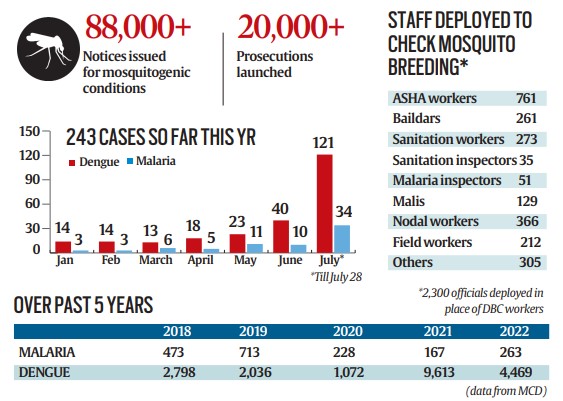Severe’ dengue strain in circulation, Delhi goes all out to keep cases in check
At several places in the Najafgarh Zone, residents claimed little to no anti-dengue activities had been carried out in the area.
 At Hindu Rao hospital. (Express Photo by Amit Mehra)
At Hindu Rao hospital. (Express Photo by Amit Mehra) With the ‘severe’ type 2 dengue strain found in a majority of samples sent for testing, the Delhi government and the Municipal Corporation of Delhi (MCD) have stepped up efforts on a war footing to manage cases of vector-borne diseases which have been steadily inching up over the past few weeks.
The situation has been exacerbated by last month’s floods that left large swathes of the city waterlogged for days and the strike by staff tasked with checking mosquito breeding.
According to MCD data, 243 cases of dengue, 72 of malaria and 14 of chikungunya have been reported till July 28. The number of dengue cases reported so far since January 1 is the highest in the last six years.

Of 20 dengue samples sent for serotyping this year, 19 had the presence of the type 2 strain. In 2015, when Delhi saw one of its worst dengue outbreaks with over 15,000 positive cases and 38 deaths reported, type 2 and 4 strains of the virus, both severe, had emerged as the dominant strains. In 1996, 432 people died due to dengue while 10,200 positive cases were reported.
To get a sense of work on the ground, The Indian Express visited the Najafgarh zone, which has one of Delhi’s largest drains, the Civil Lines and Shahdara North zones, which were severely hit during the flood, as well as hospitals.
Spot check
At several places in the Najafgarh Zone, residents claimed little to no anti-dengue activities had been carried out in the area. “Last year around June, MCD officials came to check for any stagnant water inside our homes… they also cleared water stagnating in potholes… It’s already August this year and no checks have been made,” said 68-year-old Roshini, who lives near Najafgarh drain bird sanctuary.
Shweta, a resident of Najafgarh’s Vadi Vasi village, claimed no anti-dengue programmes have ever been carried out at her home, nor have officials visited to spread awareness. “We’ve lived here for 15 years, but no dengue drives have ever been done at our home… Because the roads are poorly constructed and have many pits, water stagnates in them; this has been exacerbated by the floods, but the municipal body has made no efforts to clean it,” she alleged.
As per last week’s vector-borne disease report, Najafgarh reported five cases of dengue while South and West districts had six and five cases respectively.
An MCD official, on condition of anonymity, said in Southwest Delhi areas like Najafgarh and Mahipalpur, water supply is inconsistent which forces people to get water from tankers which they store in drums. This, he said, results in mosquito breeding.
He added that the Najafgarh area is incredibly broad, making it difficult for the corporation to cover it completely.
At Shahdara North Zone, several under-construction plots were seen in the Mansarovar Garden region — on a road with over 50 residences on each side, virtually every third property was under construction. Such sites, too, if left unchecked, become a breeding ground for larvae.
However, The Indian Express found that only one of 10 construction sites had been visited by domestic breeding checkers (DBCs) in the past three days. “DBC workers came here on July 22, they instructed me to ensure that labourers do not indulge in practices that can lead to water stagnation while building the house, handed some medicines and left,” said Amit Walia, whose house was under construction.
At Majnu Ka Tila, a colony near Yamuna, residents said DBCs visited their homes. An MCD official said the flood-affected areas of MKT and Civil Lines have been covered extensively and a number of teams were deployed for a long time to ensure there is no breeding.
“It’s domestic breeding that is an issue,” he pointed out. “A total of 62% breeding happens in domestic setups, especially in areas where water supply is not good — 32% in coolers and the other 30% inside houses in money plants, plastic containers, water tanks, and bamboo shoots.”
Moreover, the strike by 3,500 DBCs who have demanded regularisation among other things has halted work in many areas.
DBC staff are in charge of assessing homes, checking for larvae and eradicating mosquito breeding on the spot. They also run initiatives to teach people how to avoid larvae reproduction and protect themselves from water-borne diseases.
According to a senior MCD official, the number of DBC personnel is insufficient: “With over 40 lakh properties and only 3,500 domestic breeding checkers in Delhi, it is impossible for such a small workforce to check breeding in every locality; which is why many localities go unchecked,” said the official.
When asked how they plan to meet the shortage, MCD and Delhi government officials said they have diverted ASHA workers, gardeners and Group C employees for the task.
Incidentally, the MCD has announced that it will procure drones to monitor the breeding of mosquitoes and spray anti-larvae medicines. It had undertaken a trial in Usmanpur.
According to sources, it will take at least a month to float a tender for the procurement of these drones. “How effective these drones will be can only be verified once they are put into large-scale use,” said an official from the health department.
Infra boost
Officials said in view of the spike in cases, orders have been issued to commence anti-dengue measures, usually undertaken from September to November, immediately.
At a meeting conducted by health department officials with Delhi Chief Minister Arvind Kejriwal, as per sources, the CM directed that dengue cases and deaths, if any, will be reported by the government on a daily basis as done during Covid.
“Hospitals have been directed to provide a 24-hour report daily to the health department containing data on number of patients admitted with fever, new dengue cases, deaths due to dengue, and beds earmarked for dengue and its availability in government and private hospitals,” said an official from the health department, adding that more samples will be tested for determining the prevalent serotype.
Health Minister Saurabh Bharadwaj has also directed hospitals to keep 5% of hospital beds, previously allocated for Covid-19 patients, for dengue patients.
At Lok Nayak Hospital, the Delhi government’s largest facility, a fever clinic has been opened for patients. However, many reporting a fever continue to visit OPD and casualty for a checkup. “There’s a lot of confusion among patients on where to go. It will take time to streamline the process,” said a hospital official.
He added that 70 beds have been designated in the fever clinic while diagnostic facilities and mosquito nets have also been arranged to tackle a surge.
According to Lok Nayak medical director Dr Suresh Kumar, as of August 5, four patients were admitted due to dengue in the hospital. Dr Kumar, who also heads the Lal Bahadur Shastri Hospital in Khichripur, said five beds have been designated for fever patients here. However, a source at the hospital said there is no separate clinic and fever patients have been visiting the emergency and OPD.
At Hindu Rao Hospital, the MCD’s largest, a team of doctors has been measuring the temperature of patients and taking their blood samples in the OPD.
“We have been collecting samples of patients with fever. However, we are not admitting all of them. If their samples test positive for dengue or malaria, we contact them or send our staff to their houses to provide them with a consultation. If a patient’s condition turns severe, beds are arranged to admit them. However, not many patients have tested positive for dengue and malaria so far since the fever clinic started just last week,” said a junior resident doctor deployed in the OPD.
Dr Mukesh Kumar, the hospital’s medical superintendent, said 70 beds have been allotted. He added that since January, 27 cumulative cases have been reported. “As per guidelines, we have designated beds, mosquito nets and repellents, medicines, IV fluids, blood components, and malaria testing kits. A fever clinic has also been started. If numbers increase, we will make more arrangements,” he said.
According to Dr Lalit Dar, Professor, Department of Microbiology, AIIMS Delhi, it is crucial to control domestic breeding at this stage as the dengue mosquito has a very short flight range and spreads locally. “If there is domestic breeding in one house, then adjoining houses are at risk. So, checking for domestic breeding and taking precautions on a day-to-day basis and ensuring that water doesn’t stagnate in the immediate vicinity will make a great impact,” he said.
Dr Dar also said Type 2 strain cases have been increasing in the last couple of years and whatever samples he has seen so far are of type 2.
This strain is considered to be dangerous because of its ability to cause a drop in platelet count and internal bleeding. Globally, type 2 is associated with most cases of dengue hemorrhagic fever. While type 1 and type 3 usually cause symptoms such as fever, type 4 is also known to cause dengue shock syndrome (drop in blood pressure because of plasma leakage from the vessels.)
“Dengue Type 2 and Type 3 are severe but one has to realise that the proportion of severe infections is very low so far. Most patients can be managed as they have had febrile illness and require paracetamol and oral fluids to recover. A very very small proportion may require IV fluids,” he added.







